With falling birthrates and rising life expectancies, the U.S. population is rapidly aging. By 2050, according to U.S. Census Bureau projections, one-in-five Americans will be 65 or older, and at least 400,000 will be 100 or older.1 Some futurists think even more radical changes are coming, including medical treatments that could slow, stop or reverse the aging process and allow humans to remain healthy and productive to the age of 120 or more. The possibility that extraordinary life spans could become ordinary life spans no longer seems far-fetched. A recent issue of National Geographic magazine, for example, carried a picture of a baby on its cover with the headline: “This Baby Will Live To Be 120.”
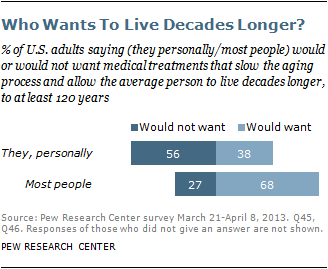
Yet many Americans do not look happily on the prospect of living much longer lives. They see peril as well as promise in biomedical advances, and more think it would be a bad thing than a good thing for society if people lived decades longer than is possible today, according to a new survey by the Pew Research Center. Asked whether they, personally, would choose to undergo medical treatments to slow the aging process and live to be 120 or more, a majority of U.S. adults (56%) say “no.” But roughly two-thirds (68%) think that most other people would. And by similarly large margins, they expect that radically longer life spans would strain the country’s natural resources and be available only to the wealthy.
There is, at present, no method of slowing the aging process and extending average life expectancies to 120 years or more. But research aimed at unlocking the secrets of aging is under way at universities and corporate labs, and religious leaders, bioethicists and philosophers have begun to think about the morality of radical life extension, according to two accompanying reports released by the Pew Research Center’s Religion & Public Life Project in conjunction with the new survey.
The survey, conducted from March 21 to April 8, 2013, among a nationally representative sample of 2,012 adults, examines public attitudes about aging, health care, personal life satisfaction, possible medical advances (including radical life extension) and other bioethical issues. The telephone survey was carried out on cell phones and landlines, in all 50 states, with an overall margin of error for the full sample of plus or minus 2.9 percentage points.2
The findings suggest that the U.S. public is not particularly worried about the gradual rise in the number of older Americans. Nearly nine-in-ten adults surveyed say that “having more elderly people in the population” is either a good thing for society (41%) or does not make much difference (47%). Just 10% see this trend as a bad thing.
Americans also appear to be generally optimistic as they look toward their own futures, including old age. Most say they are satisfied with the way things are going in their lives today (81%) and expect that 10 years from now their lives will be even better (56%) or about the same (28%). Younger adults are particularly optimistic, but even among Americans ages 65 and older, fully two-thirds expect their lives to be better (23%) or about the same (43%) in another decade. And while about a fifth of all U.S. adults (18%) say they worry “a lot” and 23% say they worry “a little” about outliving their financial resources in retirement, more than half (57%) say they either do not worry “too much” about this or do not worry about it “at all.”
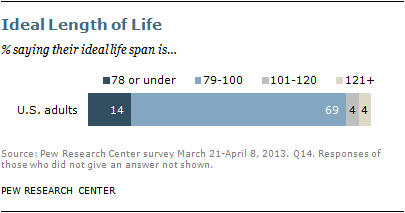
Asked how long they would like to live, more than two-thirds (69%) cite an age between 79 and 100. The median ideal life span is 90 years – about 11 years longer than the current average U.S. life expectancy, which is 78.7 years.3
The public also is optimistic that some scientific breakthroughs will occur in the next few decades. For example, about seven-in-ten Americans think that by the year 2050, there will be a cure for most forms of cancer (69%) and that artificial arms and legs will perform better than natural ones (71%). And, on balance, the public tends to view medical advances that prolong life as generally good (63%) rather than as interfering with the natural cycle of life (32%).
But there also is some wariness about new medical treatments. Only a quarter (24%) of adults say they have “a lot” of confidence that new medicines and treatments have been carefully tested before becoming available to the public. About half (54%) agree with the statement that “medical treatments these days are worth the costs because they allow people to live longer and better-quality lives,” but 41% disagree, saying medical treatments these days “often create as many problems as they solve.”
Views of Radical Life Extension

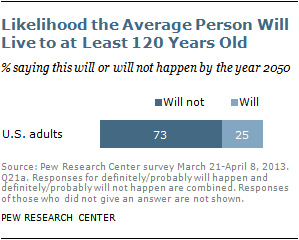
The survey seeks to provide a glimpse into people’s initial thoughts and considerations on a subject – radically longer human life spans – that could emerge as a public issue in the future. But measuring opinion about scientific breakthroughs that may or may not come to pass is difficult. Only 7% of respondents say they have heard or read a lot about the possibility that new medical treatments could in the future allow people to live much longer; 38% say they have heard a little about this possibility, and about half (54%) have heard nothing about radical life extension prior to taking the survey. Since the scientific breakthroughs are uncertain and the public does not know much about this field, the wording of the survey question focuses on the result – much longer life spans – and is deliberately vague about how, exactly, this would be achieved.
At this early stage, public reaction to the idea of radical life extension is both ambivalent and skeptical. Asked about the consequences for society if new medical treatments could “slow the aging process and allow the average person to live decades longer, to at least 120 years old,” about half of U.S. adults (51%) say the treatments would be a bad thing for society, while 41% say they would be a good thing.
But most doubt that such a breakthrough will occur anytime soon. When asked about the future likelihood of “the average person” in the United States living to at least 120 years, nearly three-quarters (73%) say it either probably or definitely will not happen by the year 2050. Just a quarter of adults (25%) consider it likely to happen by 2050.
The public also is skeptical about the fairness of these kinds of potential medical interventions. An overwhelming majority believes that “everyone should be able to get these treatments if they want them” (79%). But two-thirds think that in practice, only wealthy people would have access to the treatments.
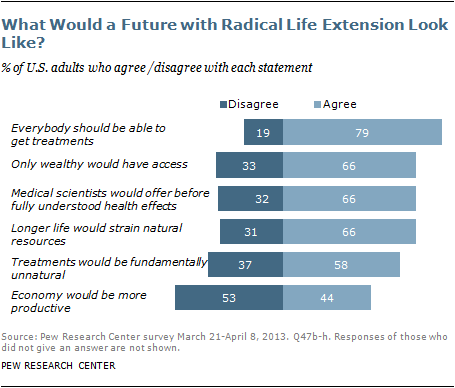
Most Americans also foresee other negative implications. About two-thirds agree that “longer life expectancies would strain our natural resources” and that “medical scientists would offer the treatment before they fully understood how it affects people’s health.” And about six-in-ten (58%) say “these treatments would be fundamentally unnatural.”
Opinion is more divided over whether “our economy would be more productive because people could work longer;” 44% agree, while about half (53%) reject this idea.
Views on the likely impact of radical life extension on society vary somewhat by age, race and ethnicity. Blacks and Hispanics are more likely than whites to see radical life extension as a positive development for society. And younger adults are more inclined than those 50 and older to say that radical life extension would be a good thing for society.
But there are few differences in opinions across other social and demographic groups. Men and women are about equally likely to say that radical life extension would be a good thing for society. There are only modest differences across education and income groups, with those who have less formal education and lower incomes somewhat more inclined to say radical life extension would be a positive development for society.
Attitudes Toward Aging and Medical Advances
Older adults account for a growing share of the U.S. population. Roughly 41 million Americans are 65 and older, and they make up about 13% of the total U.S. population, up from 4% in 1900.4 The growth in the share of older people in the population over the past century stems from dramatic advances in public health and medical care as well as steep declines in fertility rates. The share of the population that is 65 and older is growing at a faster pace than other age groups, fueled primarily by the aging of the nation’s 76 million baby boomers.
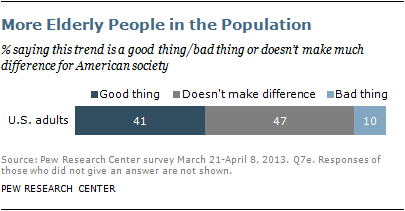
The new Pew Research survey finds that the public views this trend in American society as more positive than negative. About four-in-ten (41%) adults consider “having more elderly people in the population” a good thing for society. Just 10% say this is a bad thing, and 47% say it doesn’t make much difference.
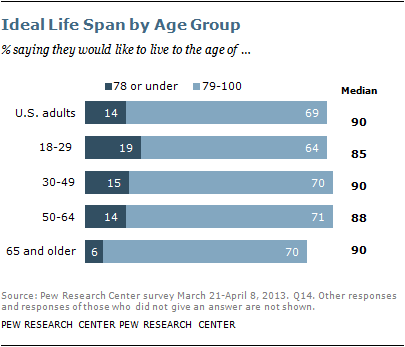
The overall average life expectancy in the U.S. at present is 78.7 years, although women tend to live longer (81.0 years) than men (76.2 years).5 Given the option, most Americans would choose to live longer than the current average. Fully 69% of American adults would like to live to be 79 to 100 years old. About 14% say they would want a life span of 78 years or less, while just 9% would choose to live more than 100 years. The median ideal life span is 90 years. Younger adults, to whom old age may seem far away, are more likely than those 65 and older to give an ideal age of 78 years or less (19% vs. 6%). The median ideal life span of adults under 30 – at 85 years – is lower than that for older adults. Relative to whites and Hispanics, blacks are especially likely to say they would choose a longer life span (median of 94 years). But whether respondents are male or female, their median ideal life span is roughly the same. And there are no significant differences in the median ideal length of lifetime by education.

Public views of medical treatments today are largely positive, though not without reservations. About two-thirds of adults (63%) say “medical advances that prolong life are generally good because they allow people to live longer,” while about three-in-ten (32%) say medical advances are bad because “they interfere with the natural cycle of life.” Further, 54% of adults believe that “medical treatments these days are worth the costs because they allow people to live longer and better-quality lives,” while 41% say that these treatments “often create as many problems as they solve.”
Overall attitudes about medical treatments are, not surprisingly, closely related to views about the likely effect of medical treatments that would radically extend the life span of human beings. Those who see medical advances in generally positive terms are also more inclined to view radical life extension as a good thing for society, and vice versa.
Differences by Religious Group
There are mostly modest differences among religious groups in their views on medical advances in general. Majorities of all large U.S. religious groups consider medical advances that prolong life as generally good.6 About half or more of adults in all the major religious groups also say that medical treatments these days are worth the costs because they allow people to enjoy longer, better-quality lives. About six-in-ten white mainline Protestants (62%) and white (non-Hispanic) Catholics (59%) hold this view, compared with about half of white evangelical Protestants (50%) and black Protestants (52%). About half or more of Hispanic Catholics (53%) and the religiously unaffiliated (55%) also say that medical treatments these days are worth the costs.
However, there is a different pattern across religious groups when it comes to attitudes about the possibility of slowing the aging process and radically extending life. Black Protestants are among the most likely to say radical life extension would be a good thing for society (54% do so). By contrast, fewer white evangelical Protestants (34%) and white Catholics (31%) say the same.
Hispanic Catholics (44%) are more likely than white Catholics (31%) to think that much longer life spans would be a good thing for society. Among the religiously unaffiliated, 43% say radical life extension would be good for society, and 51% say it would be bad for society. About four-in-ten (41%) white mainline Protestants say radical life extension would be a good thing, while 52% say it would be a bad thing for society.
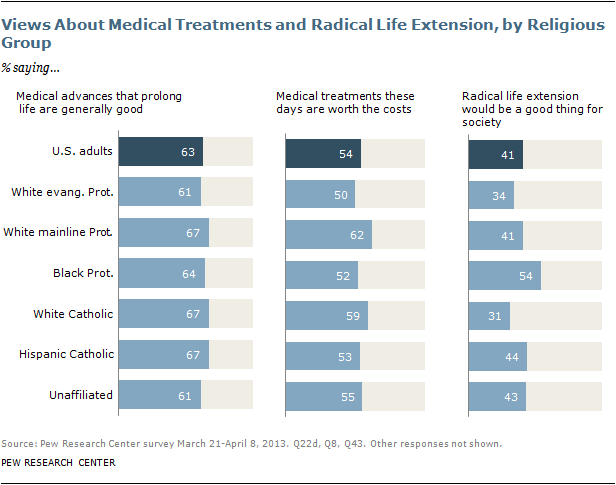
Predicting Views of Radical Life Extension
While only a minority of U.S. adults have heard about the possibility of radical life extension, those who report having heard at least a little about it are relatively more inclined to see it in a positive light. And those who expect scientific developments to dramatically increase average life spans in the next 40 years also are more inclined to view radical life extension as good for society and to say they personally would want life-extending treatments.
The survey contains a number of null findings that may be surprising. It turns out, for example, that many standard measures of religious beliefs and practices, including belief in God and frequency of attendance at religious services, are related to views on radical life extension only weakly, if at all. Nor is there a strong relationship in the survey between the gender, education or political party identification of respondents and what they say about longer human life spans.
At least one question that deals directly with death, however, is correlated with views on radical life extension. People who oppose the death penalty are more inclined to say that longer life spans would be good for society. Beliefs about medical advances in general also are predictive of where people stand: those who think medical advances are generally good are more likely to view radical life extension in positive terms and to say that they personally would want life-extending treatments.
Perhaps most intriguing, there is an association between race and ethnicity and views about radical life extension, with blacks and Hispanics more inclined than (non-Hispanic) whites to favor radical life extension for themselves as well as for society as a whole. There may be many, overlapping reasons for these differences. Blacks and Hispanics tend to hold distinctive views on a number of questions that are correlated with views about radical life extension, such as having higher expectations that such scientific breakthroughs will come to pass by the year 2050 and being more inclined to see the growth of the elderly population as good for society. The survey cannot provide a definitive explanation for these racial and ethnic differences. For an overview of how some black Protestant leaders and other clergy are approaching the issue, see “Religious Leaders’ Views on Radical Life Extension.”
Roadmap to the Report
The rest of this report details the survey’s findings on radical life extension and related attitudes toward aging, medicine, personal life, religion, and moral and social issues. The first section looks at Americans’ initial thoughts about the desirability and impact of radical life extension. The second section covers views on radical life extension by religious affiliation, beliefs and practices. The third section looks at the public’s views on aging in general. The fourth section explores attitudes toward medical treatments available today and the relationship of those attitudes to the public’s views on radical life extension. The fifth section looks at personal life satisfaction as it relates to attitudes about longevity. The sixth section considers the morality of some social issues – including views on abortion, stem cell research and the death penalty – and how those views are related to the public’s early thinking about the possibility of radically longer life spans. The seventh section provides an overview of the similarities and differences across racial and ethnic groups on views about radical life extension and beliefs about aging, medicine and personal life.
What’s the Science Behind Radical Life Extension? And What’s the Religious Debate?
In the last 200 years, advances in medicine, nutrition and public health have substantially increased human life spans. These increases have been achieved largely by helping infants and children to live to adulthood rather than by pushing the boundaries of human aging past their known limits. Today, however, scientists at major universities, research institutions and corporate labs are investigating a number of potential ways to slow down or turn back the natural clock of human aging, including growth hormone treatments, natural or drug-induced starvation diets and genetic therapies that seek to reduce or reverse the effects of aging. So far, none of these approaches has proven to be clearly effective in humans, but together they give a sense of the possible avenues ahead. For an overview of the scientific research and the emerging moral and religious debate over the possibility of much longer life spans, see the accompanying report, “To Count Our Days: The Scientific and Ethical Dimensions of Radical Life Extension.” For brief descriptions of how some major U.S. religious traditions might approach the issue, based on interviews with clergy, bioethicists and other scholars, see “Religious Leaders’ Views on Radical Life Extension.”


